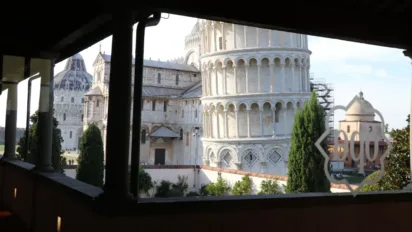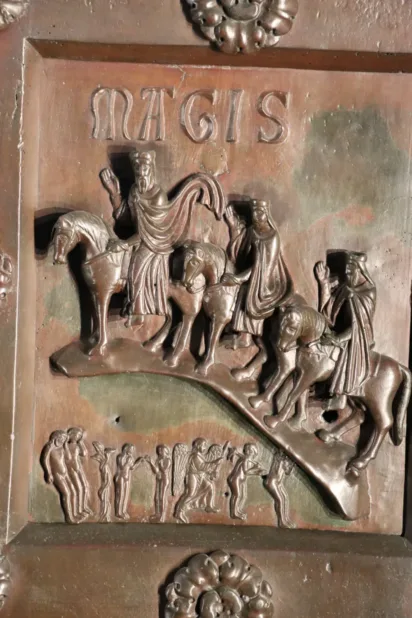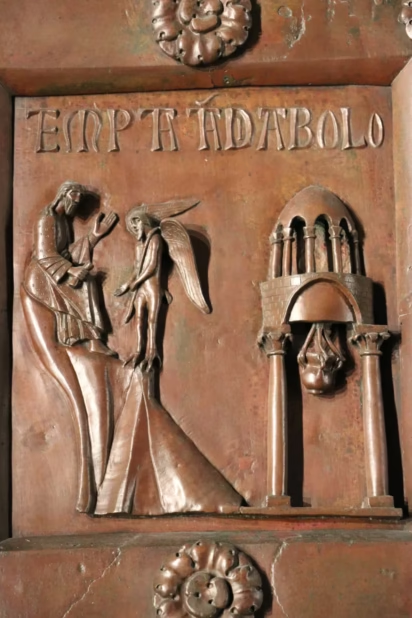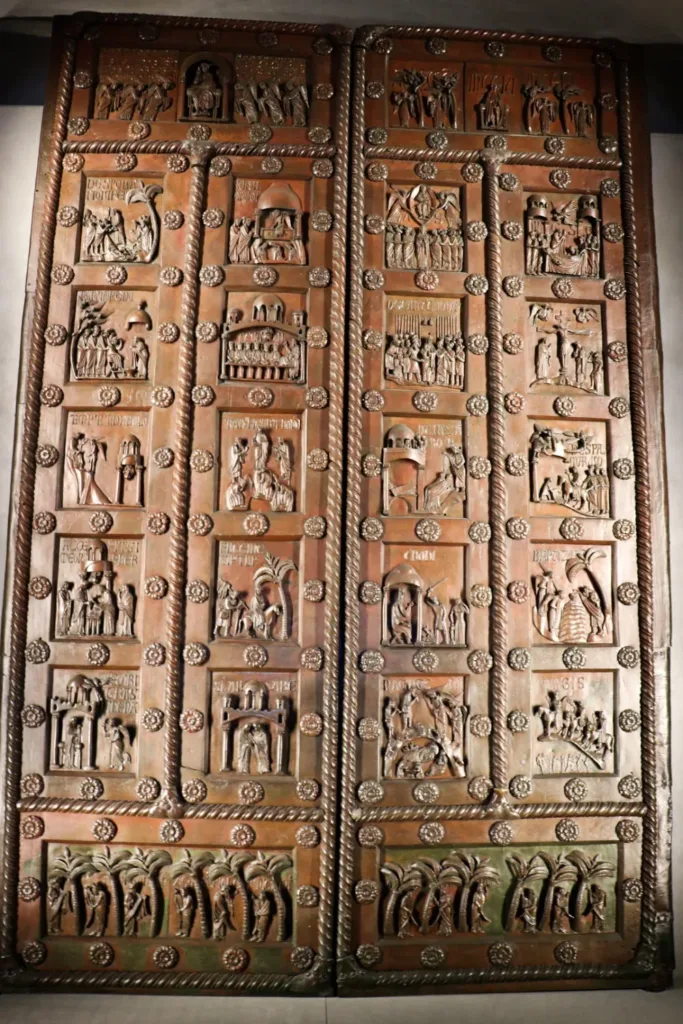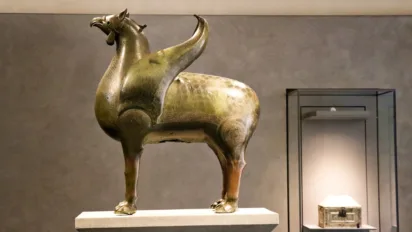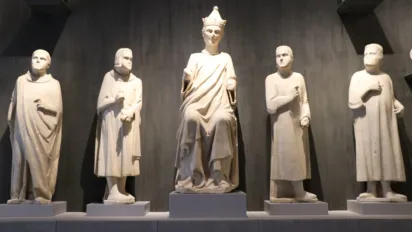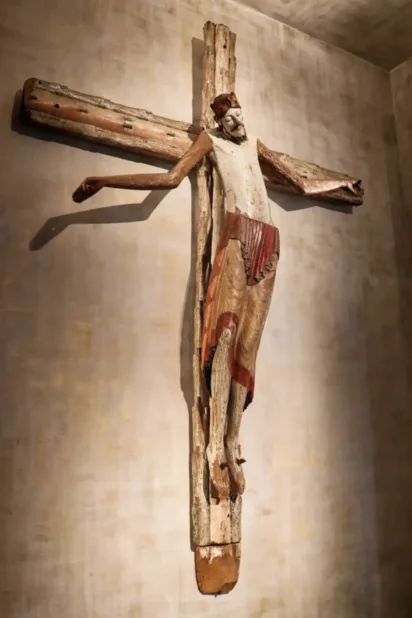The Cathedral Museum of Pisa (Museo dell’ Opera del Duomo) displays original artwork from the famous cathedral, baptistery, and leaning tower of Pisa.
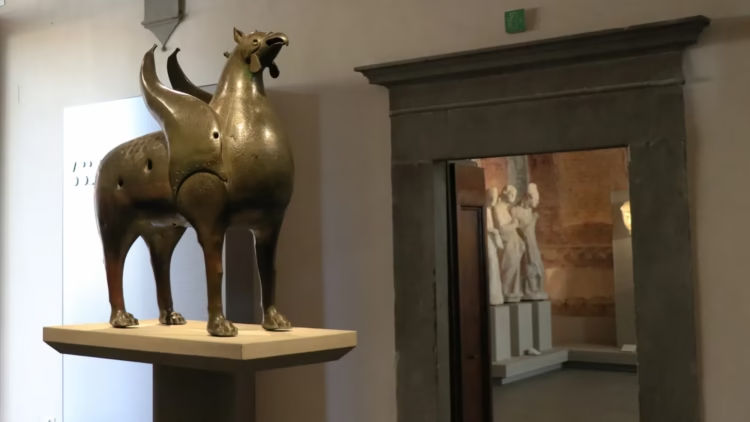
Many of the original sculptures of the Duomo, baptistery, and Camposanto Cemetery in Pisa are now preserved in the relatively small Cathedral Museum of Pisa (Museo dell’ Opera del Duomo). In addition to numerous original Gothic and Renaissance sculptures are several further decorative elements including the original bronze doors from the transept and the Islamic Griffon that once crowned the Duomo. The museum also has a small but exquisite collection of liturgical furnishings, images, vestments, vessels, reliquaries, and books on display. The small cafe with pleasant views of the Leaning Tower of Pisa is open to non-museum visitors too.
Cathedral Museum of Pisa (Museo dell’ Opera del Duomo)
The Museo dell’ Opera del Duomo right next to the Leaning Tower of Pisa houses almost exclusively items directly associated with the cathedral and related buildings on Pisa’s field of miracles.
The museum has only around 25 small rooms and is easy to enjoy. Most items are described in both Italian and English but the experience is not an information overload.
Even when crowds gather around the Leaning Tower of Pisa, the museum remains relatively quiet making it a great place to break away from the masses, enjoy the air-conditioning, and see the original artworks that have mostly been replaced with copies at the cathedral and baptistery.
Highlights of the Cathedral Museum of Pisa
The highlights of the Museo dell’ Opera del Duomo in Pisa include original detailing from the cathedral, a variety of sculptures, religious vestments, and paraphernalia.
The works on the ground floor were mainly taken from the exteriors of other buildings on the Piazza del Duomo.
One of the first sights is the impressive 12th-century bronze St Rainerius Door (ca. 1180) by Bonanno Pisano that originally provided access to the transept of the cathedral — the present door facing the Leaning Tower is a copy. (The three bronze doors by Bonanno in the western facade of the cathedral were destroyed by fire in 1595.)
The life of Christ is the main theme in the 24 decorative panels of the door. Note the double scene on the square lower right: in addition to the Three Kings (Magie), the original sin of Adam and Eve is shown in the lower corner.
Such highly decorated bronze doors were popular in the Romanesque period from Byzantium to Northern Europe (a beautiful one is in the German city Hildesheim).
A special section is devoted to foreign influences on the early cathedral as a reminder that Pisa of the Middle Ages was a very international city. Items from all over the known world were acquired, whether by trade or might.
Many items were recycled from Roman buildings while numerous decorations came from the Islamic world. A prime example of Islamic art is the 11th-century bronze Griffon-shaped fountain spout that probably came to Pisa via the Balearic Islands as war booty. (A copy now stands on the roof of the cathedral.)
Several rooms have Gothic sculptures by Pisan artists including Nicola de Apulia, Giovanni Pisano, Tino di Camino, and Lupo di Francesco. Andrea and Nino Pisano, who created many works in the Baptistery and Duomo, originated from the south but were considered Pisan to the extent that Pisa was incorporated in their name.
The altar of St Rainerius (1305), the patron saint of Pisa, is by Giovanni Pisano, who was influenced by the paintings of Giotto. The monumental tomb of Emperor Henry VII surrounded by court dignitaries and some angels was designed by Tino. (Only the sarcophagus with a reclining statue of the Emperor remained inside the Duomo.)
The liturgical furnishings, images, vestments, vessels, reliquaries, and books used by the cathedral are mostly displayed on the upper floor. Wood carvings and wood inlay works show craftsmanship of the highest order. The 12th-century painted wooden Christ on the Cross is another foreign influence — it is of Burgundian origins. Numerous religious books and codices are also on display.
In addition to traditional religious vestments, the textiles include the funeral shroud and insignia of Holy Roman Emperor Henry VII, whose untimely death of malaria in 1313 was unfortunate for Pisa that backed the Emperor’s cause both politically and financially. Dante praised Henry to the high heavens — in paradise, Dante is shown a seat of honor reserved for Henry in Heaven.
From the loggia, visitors may enjoy marvelous views of the Duomo and the Leaning Tower of Pisa. The café here is a pleasant place for a drink and small snack and is generally uncrowded despite being open for free to all.
On the wall of the gallery are colossal busts by Giovanni Pisano — these sculptures of prophets, apostles and the madonna once crowned the arcades of the baptistery.
Pisa Duomo Museum Visitor’s Information
Tickets are not sold at the museum itself — buy tickets at the Sinopie Museum or the ticket office near the Leaning Tower.
Buy Tickets for Sights in Pisa

Admission to the Field of Miracles (Campo Dei Miracoli) in Pisa and the exterior of all buildings in the area is free and possible at all times.
Tickets are available for the following sights in Pisa:
Cathedral (Duomo) — admission is free but only per time slot ticket. Pick up a free pass in person only from any ticket office. On very busy days, there may be a delay in entering the church or occasionally, no more free tickets available on the day. However, any of the paid tickets below automatically acts as a skip-the-line entry ticket to the duomo on the same day.
Climbing the Leaning Tower (Torre) — €20 per time-slot reservation tickets only. A combination pass with all other sites is around €30.
Baptistery (Battistero) / Camposanto Cemetery / Museum of the Sinopias (Museo delle Sinopie) / Museo dell’ Opera del Duomo (cathedral museum) — €7 for any site or great value at €10 for all sights.
Palazzo dell’ Opera del Duomo — admission depends on the exhibition, if any.
The two ticket offices at the Field of Miracles are inside the Sinopie Museum (near the Baptistery) and in the Palazzo dell’ Opera del Duomo (behind the church near the leaning tower).
Time-slot reservation tickets for the Leaning Tower of Pisa may be bought online at least a day in advance from Opapisa (tickets valid for a year so no refunds for any reason) or resellers such as Tiqets and Get Your Guide, which have much easier cancelation conditions. Opapisa sells tickets at most 20 days in advance while the resellers usually sell several months in advance. A variety of guided tours are available to see the sights on the Fields of Miracles of Pisa with many including climbing the leaning tower.
Opening Hours of Field of Miracles Sites in Pisa
The sights on the Field of Miracles in Pisa are open every day – exact times may be confirmed months in advance at the OpaPisa site.
All the sites are generally open as a minimum from 9:00 (10:00 for the Duomo) to 19:00. From April to September, the opening hours are usually 8:00 (10:00 for the Duomo) to 20:00 with the Camposanto and Tower open until 22:00 on some nights.
Last tickets are sold around half an hour before closing time (but expect an argument at the door if leaving it that late).
Combination tickets are valid for a year after the selected date so refunds are not given if a site is closed on a particular day(s).
More Information On Top Sights in Pisa
- See the Top Sights on Pisa’s Field of Miracles
- Tips on Buying Tickets and Tours for the Leaning Tower and Pisa Sights
- Visit the Duomo (Cathedral) of Pisa (Cattedrale)
- Visit the Baptistery of Pisa (Battistero)
- Visit the Cathedral Museum (Museo dell’ Opera del Duomo di Pisa)
- See Renaissance Frescoes in the Camposanto Cemetery
- Visit the Sinopie Museum in Pisa
- Transportation to the Leaning Tower of Pisa
- Book Guided Tours of Pisa and Day Trips at Get Your Guide
- Buy Tickets Online at Tiqets
- Book Italian Train and Intercity Bus Tickets at Omio
- More Photos of the Field of Miracles in Pisa on Flickr
